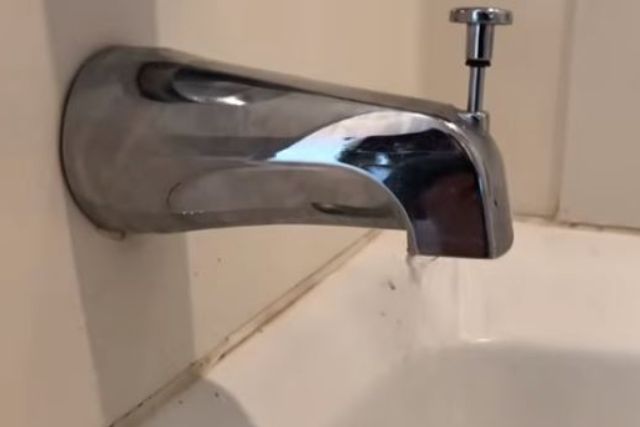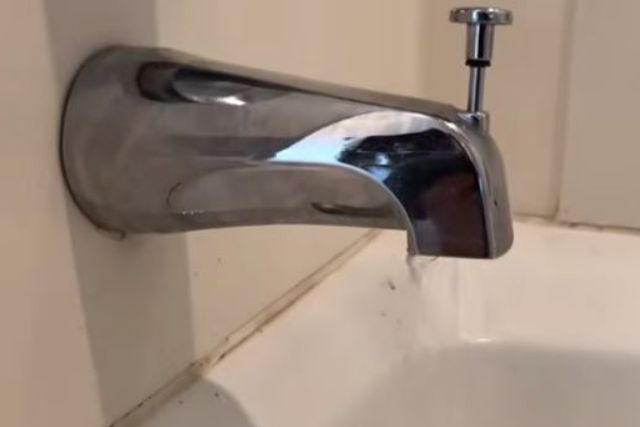Have you just stepped into your bathroom for a shower and noticed very weak water flow there? You look down and find most of the water is leaking out of your bathtub spout even the diverter knob is lifted in the showerhead position.
The fact of the shower diverter leaking while in shower mode could be:
- Loose connection at the faceplate
- Improper water pressure
- Clogged tub spout
- Broken inner components of the valve
- Or, the diverter may not installed correctly.

However, you can try to tighten any of the loose connections at the valve. Also, check for blockages in the tub spout and clean it. At times, you just need to replace the faulty rubber washer or gasket or in the worst case, the whole valve itself.
Table of Contents
Possible Reasons & Solutions For Shower Diverter Leaking [Quick Overview]
Before delving into the detailed discussion, let’s have a short glimpse at the quick table below, highlighting all the probable reasons for this issue with the corresponding solutions:
| Probable Reasons | Recommended Fix |
| Loosened faceplate screws | > Tighten the loose connection |
| Improper water pressure | > Adjust the water pressure in your shower system |
| Hard mineral build up in the tub spout | > Clean the tub spout though roughly. |
| Broken rubber washer or gasket | > Replace the faulty parts |
| Faulty installation | > Clean the tub spout through roughly. |
| Faulty diverter valve | Hard mineral buildup in the tub spout |
How To Fix A Leaky Shower Diverter Valve? [Easy Solutions]
Continuous water dripping from your diverter valve assembly is not only an interruption during your enjoyable shower but also can lead to significant water damage if left unattended.
Thus, as with detection, addressing the issue earlier is crucial to prevent further water damage and also to save you from a bigger headache down the line.
So, here is the part that will guide you in detail on how you deal with a malfunctioning shower diverter valve. But consider one after another serially to make your shower diverter valve troubleshooting journey easier.
Let’s get started!
1. Loosened Faceplate Screws
If your shower diverter drips water from the tub spout even when the shower is on, the best possibility is the screws behind the faceplate of the valve have loosened from where the leaks start.
The faceplate mainly helps hold the diverter mechanism in place and adjust the rubber gasket which creates a water-tight seal.
In case the faceplate isn’t held firmly in place, it is obvious it will move slightly. This allows the gasket to lose its compression and create a gap for water to leak through.
Even this was a very silly mistake in my case as well when I completed plumbing work in my shower system but failed to secure the faceplate.
Whatever the fact is, tightening the screws behind the valve is the quick and simplest fix for you to repair the water leakage from your shower diverter.
How To Fix:
Before doing anything else, make sure you have turned off the water supply to your shower system. Now take a screwdriver that will right fit the size of screw heads on your diverter faceplate.
Then remove the faceplate. Depending on the design, the faceplate may be held in place by screws, clips, or a combination of both. For instance, identify the fastening mechanism and use the right tool to remove the faceplate.
Once the faceplate is off, locate the diverter valve and its surrounding screws that you need to tighten. Use your screwdriver and gently turn each screw clockwise on the valve until they feel snug.
[Be mindful not to overtighten the screws as excessive force could crack the faceplate or strip the screw heads.]
When done, reattach the faceplate, turn on the water, and check for leaks.
2. Improper Water Pressure
Incorrect water pressure in your shower system is another major factor to blame if it is continuously dripping water from the tub spout even in the shower mode. For instance, we can suspect both factors- too low water pressure and too high water pressure.
Let me explain…
If the water pressure is too high for your shower system, it can put extra stress on the diverter, especially if it’s not designed to handle it. This can cause the washer or gasket to be misaligned, bend, or break at times, preventing them from closing completely and creating a leak.
Besides, most of the shower diverter valves rely on a specific level of water pressure to function optimally. With a certain amount of water pressure, it creates a secure seal and directs water to the desired outlet.
In case the water pressure is too low, the diverter may not receive enough force to create a tight seal. This insufficient sealing can result in water leaking through the diverter, even in situations when it should to the showerhead.
How To Fix:
First off, check and determine that the water pressure in your plumbing system is in the recommended range. For instance, you can use a water pressure gauge to measure the pressure. If it’s too high or too low, you may need to adjust it.
If the water pressure is too high, try to reduce the pressure from the water shut-off valve or consider installing a pressure-reducing valve (PRV) in your water supply line.
Besides, if the pressure is too low, look for any obstructions in the water supply line and remove it.
Also, ensure the water supply to the entire house is fully open.
3. Hard Water Mineral Build Up In The Tub Spout
If you pull up the diverter handle to divert water into the shower but water still drips from the tub spout, the issue may be from the tub spout itself. The best chances are it is entirely clogged with dirt, debris, or hard mineral buildup.
That would be the most common factor to the users, especially for those who have hard water with high mineral content. Over time, hard minerals deposit in tub spouts due to the presence of calcium and magnesium in hard water.
This forms a chalky substance that adheres to the spout’s surface like in the image below.
These deposits prevent the gaskets and washer from sealing properly, allowing water to easily sip out even if your diverter is in the shower mode. Don’t worry! It’s easier to clean the tub spout.
How To Fix:
Here I am sharing the tips and tricks that I always follow to clean up my clogged tub spout.
All you need to do is first grab the whole spout with your hand and turn it counterclockwise until it comes off. Now remove the diverter knit and white prongs from the connection. Then it would look like as below:
To clean up the deposits indie, you will need any descaler to dissolve the mineral. Mostly I use CLR calcium and lime remover for quick cleaning. Anyway, take a large container and fill it with CLR and water in a 1:1 ratio.
[Instead of CLR, you can use the white vinegar as well to get the same results]
Take your tub spout and put it in the solutions, making sure it’s submerged fully. Let the tub submerge in it for about 15-30 minutes.
When you find the sticky miner star loosens up and breaks, take off the tub spout and scrub it with a toothbrush to clear up any stubborn residual deposits.
Finally, rinse the tub spout with clean water and reassemble it back in connection. Hope your leaky shower diverter issue is resolved now!
4. Worn Out Rubber Washer
The rubber washer is an essential part of any shower diverter valve assembly that creates a watertight seal between the diverter valve and the corresponding port. This seal is mainly designed to prevent water from leaking out when the diverter is directing water to the other outlet.
But over time, the rubber washer becomes brittle and loses its elasticity. This causes crack, tear, or hardening to this part, reducing its ability to form a tight seal.
Also as for being always in contact with the water, hard minerals can build up on the washer, making it stiff and inflexible. This also prevents it from creating a watertight barrier with the valve and causes water to sip out.
How To Fix:
First, turn off the water supply. Unscrew the tub spout from the connection by just turning it counterclockwise. Disassemble the diverter knob and inspect the rubber washer inside for any signs of wear and tear.
If so, you will need to replace it. For instance, make sure you have the right replacement part that matches the size and type (flat or O-ring) of your original washer.
- Remove the worn-out rubber washer and place the new part back in the gasket. But before that, it would be better if you could apply silicon grease to make it seal better.
- Now put the diverter pull knob through the spout and hold it in one hand. Insert the white diverter prongs and press down with your other hand. You will hear a Click making sure that it fits snugly on the diverter wall.
- Finally, put back any components you removed in reverse order. Turn on the water supply and check for leaks around the diverter.
- If water is dripping from the tub spout of the diverter valve connection, secure the connection more but avoid over-tightening.
5. Faulty Installation
If you recently replaced your shower diverter and it starts leaking, the best possibility is the diverter isn’t installed correctly. Even you are not alone here. Most users often fail to maintain the correct instructions to ensure the proper installation of this major part.
However, if your newly installed diverter valve is leaking water, either it is aligned properly or has a secure fit. And for this reason, it leaks around the connections or the faceplate. Here I have listed the common mistakes that users make:
# Using the wrong washer/gasket: If you are not using the correct size or type of washer for your diverter model, it leads to an inadequate seal.
# Overtightening screws: While loose screws can cause leaks, overtightening them can also damage the diverter housing and create new leak paths.
# Inadequate thread sealant: This is the most obvious factor to blame if your 2 or 3-way shower diverter leaks. If the thread sealants on the valve weren’t applied to the connections properly, water could leak out from the threads.
How To Fix:
In this step, you will recheck the installation instructions for your specific shower diverter model and ensure you follow all of those. Then inspect if there’s a slight gap between the diverter and the shower arm or tub spout. If so, realign the parts and create a tighter seal.
In case your 3-way shower diverter leaking from the joint, use a wrench or pliers and tighten any loose connection between the threads and the valve body as much as you can.
6. Damaged Shower Diverter Valve Or Tub Spout
After long trying if still the water is leaking out of your bathtub spout or the diverter valve itself, I bet you are dealing with a broken diverter valve or faulty tub spout that needs replacement.
The fact is not something like the shower is leaking, but obviously, you don’t want to waste water, even if it’s just a little drip.
How To fix:
With the faulty or damaged diverter valve, nothing but you will need to replace it. In the case of diverter valve replacement parts, it will be better if you have a diverter kit in this instance.
But, it would be harder for you to find the right replacement part for the specific brand and model of the shower system. As a solution, you may need to replace the bathtub spout altogether.
Anyway, it is easier to replace and set up a new diverter valve, and in the best cases you can do it by yourself. If required, hire a professional for this task.
Pro Tips To Prevent Water Leakage From Shower Diverter Valve In Future?
The only way to prevent unwanted water leakage from your diverter valve is to reduce strain and wear on the valve. This will help you the most from frequent shower diverter valve repair. For instance, follow the below tips to ensure the smooth operation of your shower diverter valve:
Tip #1: Always, release the diverter valve first to let the water run from the tub faucet for a few seconds before turning off the water.
This is because when you turn off the water, the increased water pressure in the pipe may put strain on the diverter valve. By releasing the diverter, you will allow the excess pressure to escape, reducing the wear and tear on the valve.
Tip #2: Keep your shower diverter always clean to prevent dust and hard mineral buildup. Use a mild soap and water solution or a vinegar-based cleaner to remove any mineral deposits or build-up.
Tip #3: Avoid using harsh chemicals or cleaning products on the diverter, as they can damage the finish and seals.
Tip #4: After cleaning, apply a thin film of silicone lubricant to the valve stem and O-ring to ensure smooth operation and prevent wear and tear.
Tip #5: Avoid forcing the diverter handle or twisting it excessively. This can damage the internal components and lead to leaks.
Tip #6: To ensure the action from the diverter and to prevent unusual damage, you can consider installing a Positive Action Shut-off Mixer tub spout diverter in your shower system.
The positive action shut-off mechanism ensures that the water is completely turned off when the diverter is in the off position. This helps to prevent leaks and wasted water.
FAQs:
Is there a way to fix a leaky shower diverter without replacing it?
Yes, there are several ways to repair your leaky shower diverter, including cleaning the tub spout, replacing the broken washer, ensuring the proper installation of the valve, and so on. But depending on the severity of the leak, you may need to replace it.
How to determine that my shower diverter is broken and is longer for use?
The major visible sign of a broken shower diverter includes water leaks around the diverter body, loose or wobbly handle, and difficulties in switching between the showerhead and tub spout. Also, you will notice inconsistent flow from the shower or grinding noises coming during operation.
How do I fix a shower diverter push button?
First, pull the escutcheon off and take out the diverter stem. Look for any wear and tear in the inner rubber washer and gasket. Also, the spring inside the button may be broken and needs replacement. It’s always a good idea to lubricate the O-rings with grease before installing the diverter.
Why do shower diverter valves fail?
Several factors contribute here for a faulty shower diverter. That includes broken seals from wear and tear, corroded inner threads, hard mineral build up in the tub spout, improper installation, excessive pressure, chipped finish, or faulty caulking.
How much does it cost to repair a leaky shower diverter valve?
Well, the factors depend on the severity of the leaks and the underlying causes. In simple cases, it is easier to fix the issue at no cost. But if you are replacing the valve, you can expect to pay from $225 to $575, including the material and labor costs.
In Closing!
There is nothing more annoyance when you have just lifted the diverter valve for a comfortable shower and there is inconstant water flow. What’s the problem? You notice your shower diverter leaking and water continues to drip from the tub spout!!
Well, the problem is more likely related to wear and tear in the diverter valve. At times, a thorough cleaning of the tub spout will help to get rid of the issue. Or at times, you need to go through a costly repair process to replace the faulty valve.
What the fact is, we have nicely explained the needed solution steps to deal with a leaky shower diverter valve. Hope all have reached enough information for you. You may be also interested to learn more about How To Deal With Moen Shower Handle Stuck to be more expert in plumbing work!


About Atikul
Atikul Islam shares his expertise with various tips & tricks to fix the problems with home appliances related to toilet, kitchen, bathroom, heating, & cooling systems. Read to know more about Atikul Islam.